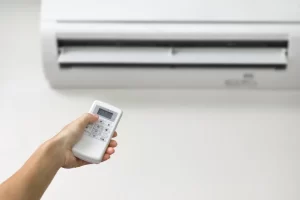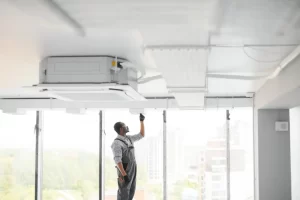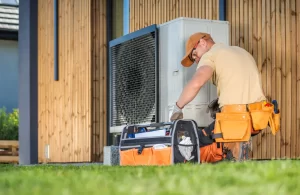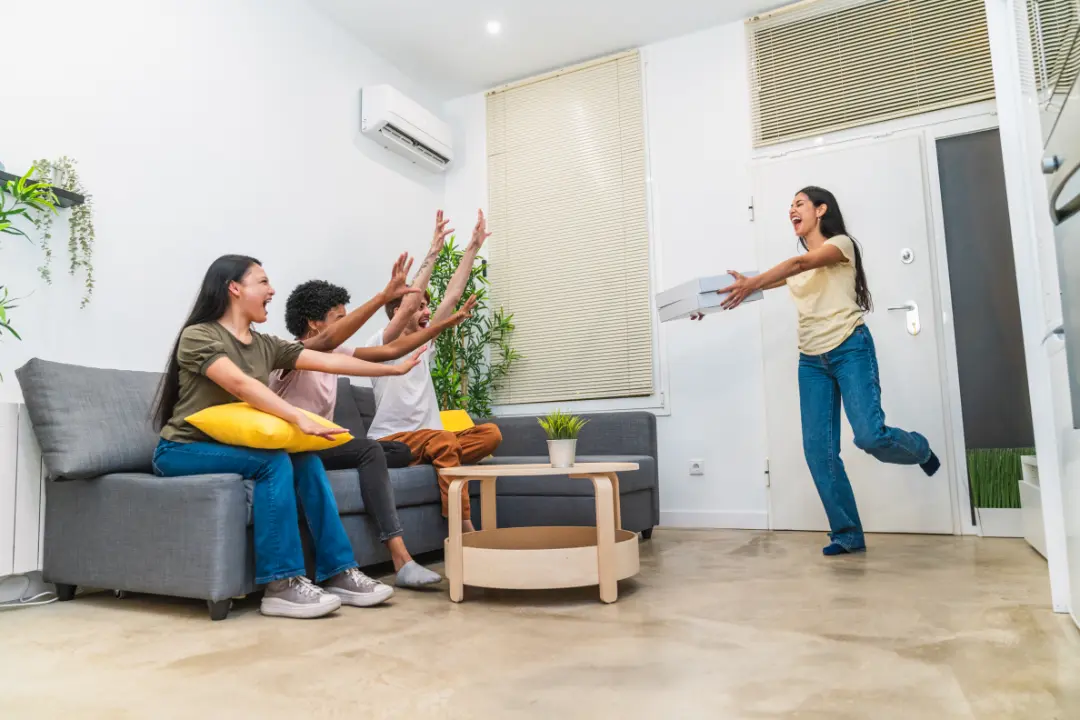Are you facing inconsistent temperatures and wondering how to balance your air conditioning airflow? Balancing air conditioning airflow can make a world of difference in comfort and energy efficiency.
This comprehensive guide will help you understand how to achieve balanced airflow throughout your space, ensuring a comfortable and energy-efficient environment.
Key Takeaways
- Balanced airflow in HVAC systems optimises temperature distribution, increases comfort, and improves energy efficiency. Adjusting intake and outflow and resolving uneven airflow or negative pressure issues requires professional tools and expertise.
- SmartWay Air Conditioning offers professional air conditioner installation, maintenance and repair services to maximise performance and comfort.
- Regular AC system maintenance is crucial for maintaining balanced airflow, preventing system issues, prolonging the system’s lifespan, and ensuring a healthier indoor environment.
Why Balanced Airflow is Essential for Air Conditioning Systems
Achieving balanced airflow, or HVAC air balancing, is critical to ensuring consistent temperature distribution, comfort, and energy efficiency. This process involves adjusting the system’s intake and outflow, eliminating hot and cold spots, and resolving issues like negative pressure.
When done correctly, air balancing not only enhances comfort but also reduces energy consumption and wear on HVAC components, saving costs and improving overall performance.

Identifying Common Airflow Imbalances
The solution begins with an accurate diagnosis. Do you notice uneven temperatures between rooms or uncomfortable drafts? These are common signs of imbalanced airflow. Cool air naturally falls while warm air rises, leading to circulation issues in multi-level spaces. Additional indicators of airflow problems include excessive noise from the HVAC system, higher energy bills, and uneven comfort levels across different areas.
Professional diagnostics can identify underlying issues, such as duct damage or improper sizing, which contribute to these imbalances.
Advanced Diagnostics
Understanding how air flows through your space is the first step to achieving balanced air conditioning. HVAC professionals measure and adjust air volume, often creating a virtual map of your building’s airflow to identify temperature inconsistencies. By tailoring solutions based on actual airflow dynamics, technicians can significantly improve both comfort and energy efficiency.
HVAC technicians will use advanced diagnostic tools to fine-tune your system.
Enhancing Air Quality Through Balanced Airflow
Balanced airflow does more than regulate temperature; it plays a crucial role in improving indoor air quality. Effective air exchange reduces the buildup of mould spores, pollen, and dust, enhancing overall air quality and promoting a healthier living space.
Proper ventilation and air distribution prevent stale air, excess humidity, and the accumulation of indoor pollutants, all of which can negatively impact health.
Furthermore, a well-balanced HVAC system offers several benefits:
- Acts as a barrier against outdoor allergens and impurities.
- Keeps vents clear of obstructions, maintaining quality and airflow balance.
- Supports the use of whole-house humidifiers to manage moisture levels, benefiting respiratory comfort and preserving wood furnishings.

DIY Tips for Air Balancing
While professional air balancing is recommended, there are several DIY strategies you can employ to improve airflow:
- Adjust Dampers and Registers: Manage airflow by adjusting dampers on duct lines and registers in individual rooms to correct temperature imbalances.
- Use Fans or Portable AC Units: Redirect air to areas needing more cooling or heating.
- Close Vents in Unused Rooms: Redirect conditioned air to frequently used spaces.
- Insulate Windows and Doors: Prevent drafts and maintain consistent temperatures throughout your home.
These simple adjustments can help address uneven temperatures, especially when combined with regular monitoring and minor tweaks to your HVAC settings.
Vent and Register Adjustments
Properly adjusting vents and registers can significantly enhance temperature distribution and overall comfort. Technicians often adjust dampers and control devices on air registers to optimise airflow balance within a property. Ensuring vents are unobstructed helps maintain the desired airflow, reduces strain on the HVAC system, and prolongs its operational lifespan.
Using Ceiling Fans Effectively
Ceiling fans can support your air conditioning efforts by promoting better air circulation. Set fans to spin counterclockwise in the summer to create a cool breeze and clockwise in the winter to distribute warm air evenly. This simple adjustment can significantly boost comfort without overburdening your HVAC system.
When to Consider Upgrading Your HVAC System
Sometimes, despite your best efforts at maintenance and air balancing, your HVAC system may still fall short of delivering the desired level of comfort and efficiency. In such cases, it may be necessary to consider a system upgrade. Persistent issues such as frequent repairs, increasing energy costs, and uneven room temperatures could indicate that a system replacement is more cost-effective in the long run.
Ageing HVAC systems—specifically air conditioners older than 10 years and furnaces or boilers older than 15 years—should be evaluated for potential upgrading as they are likely past their prime performance years. If you experience humidity imbalances, excessive dust, or noisy operations, these could be signs of deeper issues with your existing HVAC system or ductwork, warranting a professional assessment to determine if an upgrade is the next step.
For complex HVAC challenges that persist despite maintenance or air balancing attempts, seeking professional advice is crucial to determine the most effective solution.
Smartway’s Approach to Precision Air Balancing
At Smartway Air Conditioning, the mission is to ensure your air conditioning system performs optimally, and precision air balancing is the cornerstone of this commitment. With over three decades of experience, SmartWay Air Conditioning stands as a beacon of reliability in air balancing services, offering a 100% satisfaction guarantee that is a testament to their expertise in all of our service areas,
The highly trained technicians at Smartway offer the following services:
- Advanced diagnostic skills
- Advanced diagnostic tools
- Precise air balancing
- Improved system performance
- Enhanced comfort for their clients
Regular Maintenance: The Key to Consistent Air Balance
Consistent maintenance is the cornerstone of a well-balanced HVAC system. SmartWay Air Conditioning provides comprehensive inspections, including checks on air filters, ductwork, electrical connections, and refrigerant levels. Seasonal check-ups help maintain optimal airflow, prevent potential issues, and extend the system’s lifespan. Regular maintenance also involves replacing or cleaning air filters every one to three months to ensure efficiency and maintain a healthier indoor environment.

Enhance Your Comfort with Smart Thermostats
Smart thermostats are an effective tool for enhancing comfort and maintaining balanced airflow. These devices learn your temperature preferences and adjust settings automatically to optimise energy use.
They also provide valuable data on your HVAC system’s performance, helping you identify and address airflow imbalances. By integrating smart thermostats into your air balancing strategy, you can achieve precise control over your indoor environment, enhancing comfort and efficiency.
Ensure Proper Insulation on Airflow
Proper insulation is a critical component of balanced airflow. Inadequate insulation can lead to temperature inconsistencies and increased strain on your HVAC system.
By ensuring that your home is well-insulated, especially in the attic and around windows and doors, you can reduce heat loss and gain, maintain consistent temperatures, and improve overall system efficiency. Proper insulation works hand-in-hand with balanced airflow to create a more comfortable and energy-efficient home.
Addressing Airflow Issues in Older Homes
Older homes often present unique challenges when it comes to airflow balance. Outdated ductwork, poor insulation, and old HVAC systems can all contribute to uneven temperatures. Retrofitting older homes with modern duct designs, upgrading insulation, and installing more efficient HVAC units can significantly improve airflow balance.
If you live in an older home, consider consulting with a professional to assess your system and develop a tailored plan to address any imbalances.
The Role of Humidity Control in Airflow Balance
Humidity control is an often overlooked aspect of airflow balance. High humidity can make a space feel warmer, while low humidity can make it feel cooler than the actual temperature.
Integrating humidity control solutions, such as whole-house dehumidifiers or humidifiers, can help maintain the ideal moisture levels in your home, enhancing comfort and supporting balanced airflow. Proper humidity control also helps protect your home from issues like mould growth and wood damage.
Frequently Asked Questions
What is air balancing, and why is it important?
Air balancing is important because it improves comfort levels, air quality, and energy efficiency by ensuring consistent temperature distribution and airflow throughout a space. This process reduces wear on HVAC components and optimises the system for better performance.
Can I perform air balancing myself, or do I need a professional?
For the most effective results, opt for professional air balancing, as it requires specialised tools and expertise beyond what can be achieved through DIY methods.
What regular maintenance tasks are crucial for maintaining air balance?
Regular maintenance tasks crucial for maintaining air balance include comprehensive inspections, replacing or cleaning air filters every one to three months, ductwork upkeep, and ensuring the outdoor unit is clean and debris-free. Keeping up with these tasks is essential for optimal air balance and system efficiency.
Conclusion
Achieving a perfectly balanced air conditioning system is an art that enhances comfort, air quality, and energy efficiency. Embrace the transformative power of balanced airflow to create a harmonious and healthy living or working environment. Let this be your stepping stone to a cooler, more efficient, and comfortable space.
At SmartWay Air Conditioning Sydney, we are committed to delivering exceptional customer service and top-notch air conditioning solutions that you can trust. Our team of skilled technicians, with decades of experience, is dedicated to helping you achieve optimal indoor comfort. Whether you need routine maintenance, urgent repairs, or a complete system installation, SmartWay is your go-to partner for all air conditioning services across Sydney. Contact us today for a free estimate.


